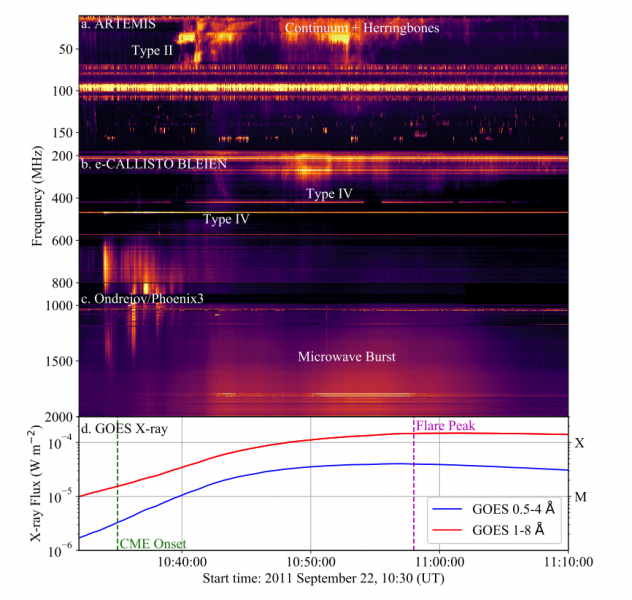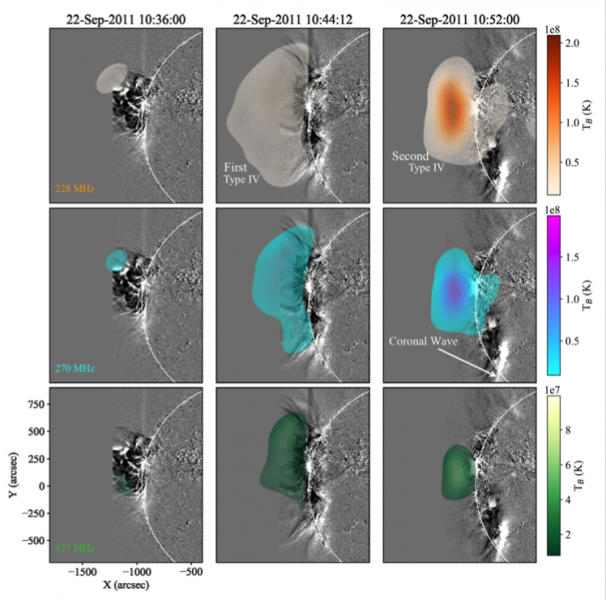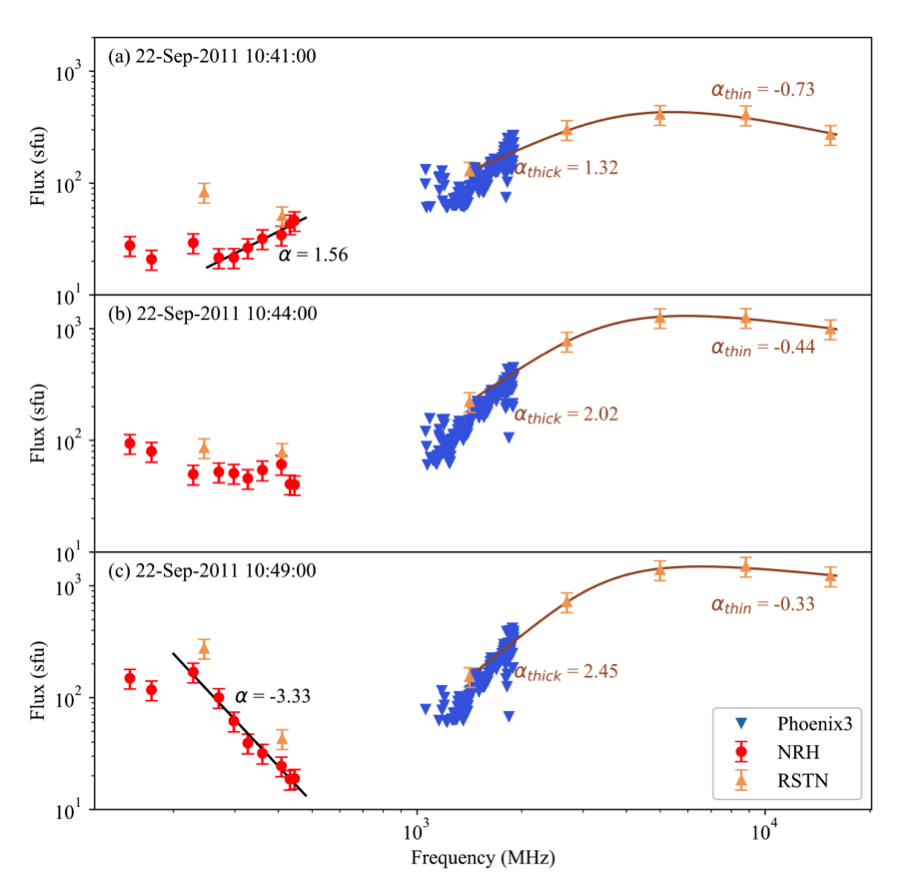Coronal mass ejections (CMEs) are sometimes accompanied by continuum emission at decimetric and metric wavelengths, called Type IV radio bursts. Of particular interest to determining CME properties are moving Type IV radio bursts, which are broadband radio sources moving outwards from the Sun. First studies suggested that moving Type IV bursts are emitted by synchrotron or gyro-synchrotron emitting electrons that are trapped inside CME loops (Dulk 1973). However, since their discovery, a number of stationary Type IV radio sources have also been observed, believed to be generated by the plasma emission mechanism (Benz & Tarnstrom 1976), while some moving Type IV bursts have also been identified as plasma emission (Gary et al. 1985). So far, the emission mechanism of Type IV bursts seems to vary on a case-by-case basis and it is not yet clear what leads to the generation of various Type IV radio bursts.
 Figure 1 – Radio bursts associated with the 22 September 2011 flare and CME. (a) Type II and continuum emission observed by the ARTEMIS spectrograph at frequencies <200 MHz. (b) Type IV bursts observed by e-CALLISTO BLEIEN at 200–400. (c) Microwave burst observed by the Ondrejov Spectrograph (0.8–1 GHz) and Phoenix3 spectrometer (1–2 GHz). (d) GOES X-ray light curve of the X1.4 flare on 22 September 2011
Figure 1 – Radio bursts associated with the 22 September 2011 flare and CME. (a) Type II and continuum emission observed by the ARTEMIS spectrograph at frequencies <200 MHz. (b) Type IV bursts observed by e-CALLISTO BLEIEN at 200–400. (c) Microwave burst observed by the Ondrejov Spectrograph (0.8–1 GHz) and Phoenix3 spectrometer (1–2 GHz). (d) GOES X-ray light curve of the X1.4 flare on 22 September 2011
On 22 September 2011, an X1.4 class flare occurred on the eastern limb of the visible solar disc, which was accompanied by a fast CME. The flare and CME were associated with radio emission at frequencies ranging from a few hundred kHz to tens of GHz, observed by multiple instruments. The flare and CME were accompanied by Type III radio bursts, a Type II radio burst and continuum-like emission at frequencies <100 MHz, and a broad continuum at higher frequencies (Figure 1). In this study, we analyse the emission mechanism and origin of a Type IV radio burst at frequencies of 200–400 MHz observed in radio images from the Nançay Radioheliograph (NRH; Figure 2).
We identified two components in the Type IV radio burst: an earlier stationary Type IV showing a large extended source located on top of the post-eruption flare loops (first Type IV in Figure 2 at 10:40-10:46 UT), and a later moving Type IV burst covering the same frequency band with a more compact source, moving outwards behind the CME (second Type IV in Figure 2 after 10:46 UT). The first Type IV has a low flux density (∼100 sfu, where 1 sfu = 10−22 W m2 Hz−1 ) and it is unpolarised. The second Type IV emission is significantly brighter (∼600 sfu), consists of bursty components across NRH frequencies and it is up to 80% circularly polarised.
 Figure 2 – Radio source locations observed by the NRH associated with the 22 September 2011 CME. The radio sources (filled contours) are overlaid on AIA 211 Å running-difference images. The radio sources are shown from top to bottom at three different frequencies of 228, 270, and 327MHz and from left to right at three different times of 10:36, 10:44, and 10:52 UT.
Figure 2 – Radio source locations observed by the NRH associated with the 22 September 2011 CME. The radio sources (filled contours) are overlaid on AIA 211 Å running-difference images. The radio sources are shown from top to bottom at three different frequencies of 228, 270, and 327MHz and from left to right at three different times of 10:36, 10:44, and 10:52 UT.
Flux density spectra of the Type IV burst were computed through time in order to determine its emission mechanism. We combined the flux density of the individual Type IV sources from NRH images with flux calibrated data from the Phoenix3 spectrometer and RSTN of the full solar disc (Figure 3). The high frequency emission (>1000 MHz), corresponding to the microwave burst in Figure 1, shows a typical gyro-synchrotron spectrum in all panels of Figure 3. The Type IV observed at NRH frequencies appears to be unrelated to the microwave burst and shows changing behavior through time.
 Figure 3 – Flux density spectrum during the occurrence of the Type IV radio burst at (a) 10:41 UT, (b) 10:44 UT, and (c) 10:49 UT. The NRH flux densities are represented by red circles, fitted with a power-law function to obtain the spectral index. The RSTN data are represented by orange triangles fitted by a gyro-synchrotron function. The Phoenix3 data points are represented by blue inverted triangles.
Figure 3 – Flux density spectrum during the occurrence of the Type IV radio burst at (a) 10:41 UT, (b) 10:44 UT, and (c) 10:49 UT. The NRH flux densities are represented by red circles, fitted with a power-law function to obtain the spectral index. The RSTN data are represented by orange triangles fitted by a gyro-synchrotron function. The Phoenix3 data points are represented by blue inverted triangles.
The flux density spectra confirm that there are indeed two separate components as the emission mechanism of the Type IV continuum appears to change over time (Figure 3). At 10:41:00 UT, the flux density of the first Type |V component increases with frequency (red circles in Figure 3a), while at 10:49:00 UT, the flux density of the second Type IV component decreases with frequency (red circles in Figure 3c). The increase and decrease of flux with frequency has a power-law behaviour. The spectral index of the Type IV in the NRH frequency range is initially negative with a value of $\alpha$=1.56, which falls in the range of gyro-synchrotron spectral indices (Nita et al., 2004) and is therefore indicative of gyro-synchrotron emission. The spectral index then progressively flattens until it becomes positive in the case of the second Type IV component, which is indicative of plasma emission.
The first component of the Type IV burst, which is stationary, is most likely emitted by gyro-synchrotron electrons that are trapped inside post-eruption flare loops. The second component of the Type IV burst has opposite characteristics: it is moving, it has consistently negative spectral indices over time, higher brightness temperature and bursty, highly-polarised emission. Therefore, the second Type IV component is most likely emitted by a coherent emission mechanism following the acceleration of electrons in the wake of the CME, such as plasma emission or electron-cyclotron maser (ECM) emission.
Conclusions
The flare and CME on 22 September 2011 were accompanied by numerous radio bursts, including a prominent Type IV continuum that showed both stationary and moving components. Most interestingly, the emission mechanism of the observed Type IV continuum was found to change over time from showing gyro-synchrotron emission of electrons trapped inside post eruption loops to plasma or ECM emission from electrons accelerated behind the CME.
Additional info
Based on recent publication, Morosan et al., 2019, A&A, 623, A63. https://doi.org/ 10.1051/0004-6361/201834510
References
Dulk, G. A. 1973, Sol. Phys., 32, 491
Benz, A. O., & Tarnstrom, G. L. 1976, ApJ, 204, 597
Gary, D. E., Dulk, G. A., House, L. L., et al. 1985, A&A, 152, 42
Nita, G. M., Gary, D. E., & Lee, J. 2004, ApJ, 605, 528
*Full list of authors: Diana E. Morosan, Emilia K. J. Kilpua, Eoin P. Carley and Christian Monstein
